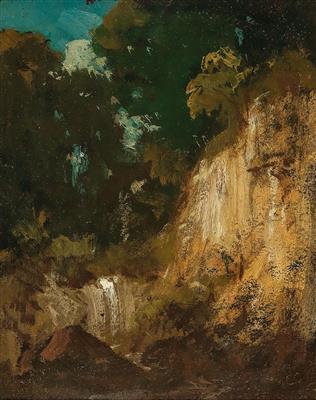Carl Spitzweg

(Munich 1808–1885)
A forest gorge, on the reverse a certificate of authenticity Schweinfurt 1924 by Prof. P. Holz, oil on board, 19.5 x 15.5 cm, framed, (W)
Provenance:
Collection of Marie Hagn (1845–1927), Munich (widow of the artist Ludwig von Hagn (1819–1898), a friend of Carl Spitzweg;
Private Collection Germany;
Collection of Maximilian Schell (1930–2014), Vienna and Preitenegg;
his heirs;
Private Collection Austria.
Catalogued and illustrated in:
Siegfried Wichmann, Carl Spitzweg. Verzeichnis der Werke, Stuttgart 2002, p. 131, no. 64.
Carl Spitzweg grew up in a middle-class family and initially trained as a pharmacist, graduating with distinction from Munich University with a degree in pharmaceutical sciences. He pursued his profession for several years before devoting himself entirely to his vocation as a painter due to health issues. He was able to pursue this passion without financial worries. As a self-taught painter, he was always keen to be acknowledged as a professional artist. This status was officially granted upon his appointment as an honorary member of Munich’s Academy of Fine Arts in 1868.
Spitzweg’s small-scale genre paintings were well received by bourgeois fans and decorated the parlours of ordinary people’s homes. These works reflected the everyday life of the bourgeoisie. In addition to these charming snapshots, which always feature an undertone of irony, he also devoted himself to landscape painting. Together with his painter friend Eduard Schleich the Elder, he undertook hikes and mountain tours in the area surrounding Munich. In the 1830s, he hiked up the Isar from Tölz (today Bad Tölz) and criss-crossed the region around Lenggries. During these expeditions, he sketched shapes and atmospheres that were typical of the landscape. These early pictures are characterised by predominantly bright illumination in the foreground and are the beginning of a new concept of landscapes, which later had a decisive impact on the Munich school. The present lot, which depicts a forest gorge, probably also dates from the period between 1835-40, when some of his gorge paintings were created.
Spitzweg painted directly from nature and, especially in his later works, combines the Barbizon school with the Munich tradition of painting. But even his early, small landscapes are strongly influenced by the immediate moment and impressions of it. For him, the air and atmosphere were carriers of light and therefore more colourful than the land; the focus clearly lay on depicting the liveliness of a moment. He uses a fast painting technique, almost as if he is producing a study or a sketch, so that he can adapt to the rapidly changing air and accurately portray the atmosphere in question. His small-format landscapes have a certain drama of their own in the brushstrokes, and Siegfried Wichmann notes that in the present lot “Spitzweg applies colour in impasto manner with wide brushstrokes in a broad, dappled painting, while the backdrop of trees is rendered with diverse shades of green and blackish shadows above the rocks. The clouds, too, are light and depicted with a wide brushwork. Spitzweg’s broadly filled brush movements are typical contemplative exercises undertaken by his visual imagination in all phases of his oeuvre, whether early, mature or late. The gorge here is characterised by the large figure of a human being, a fantastical rendering which he translated into his pictures of geologists.” (Siegfried Wichmann, Carl Spitzweg, Stuttgart 2002, p. 131.)
These small-format landscapes, known as cigar box boards, provided Spitzweg with a sizeable reserve to draw on in his later years when it was no longer possible for him to paint outdoors due to his health. This early work by Spitzweg is an outstanding example of the new open concept of landscape painting which was to become influential for the painters of the Munich school.
Esperta: Dr. Christl Wolf
 Dr. Christl Wolf
Dr. Christl Wolf
+43-1-515 60-377
19c.paintings@dorotheum.at
23.10.2019 - 17:00
- Prezzo realizzato: **
-
EUR 19.050,-
- Stima:
-
EUR 15.000,- a EUR 25.000,-
Carl Spitzweg
(Munich 1808–1885)
A forest gorge, on the reverse a certificate of authenticity Schweinfurt 1924 by Prof. P. Holz, oil on board, 19.5 x 15.5 cm, framed, (W)
Provenance:
Collection of Marie Hagn (1845–1927), Munich (widow of the artist Ludwig von Hagn (1819–1898), a friend of Carl Spitzweg;
Private Collection Germany;
Collection of Maximilian Schell (1930–2014), Vienna and Preitenegg;
his heirs;
Private Collection Austria.
Catalogued and illustrated in:
Siegfried Wichmann, Carl Spitzweg. Verzeichnis der Werke, Stuttgart 2002, p. 131, no. 64.
Carl Spitzweg grew up in a middle-class family and initially trained as a pharmacist, graduating with distinction from Munich University with a degree in pharmaceutical sciences. He pursued his profession for several years before devoting himself entirely to his vocation as a painter due to health issues. He was able to pursue this passion without financial worries. As a self-taught painter, he was always keen to be acknowledged as a professional artist. This status was officially granted upon his appointment as an honorary member of Munich’s Academy of Fine Arts in 1868.
Spitzweg’s small-scale genre paintings were well received by bourgeois fans and decorated the parlours of ordinary people’s homes. These works reflected the everyday life of the bourgeoisie. In addition to these charming snapshots, which always feature an undertone of irony, he also devoted himself to landscape painting. Together with his painter friend Eduard Schleich the Elder, he undertook hikes and mountain tours in the area surrounding Munich. In the 1830s, he hiked up the Isar from Tölz (today Bad Tölz) and criss-crossed the region around Lenggries. During these expeditions, he sketched shapes and atmospheres that were typical of the landscape. These early pictures are characterised by predominantly bright illumination in the foreground and are the beginning of a new concept of landscapes, which later had a decisive impact on the Munich school. The present lot, which depicts a forest gorge, probably also dates from the period between 1835-40, when some of his gorge paintings were created.
Spitzweg painted directly from nature and, especially in his later works, combines the Barbizon school with the Munich tradition of painting. But even his early, small landscapes are strongly influenced by the immediate moment and impressions of it. For him, the air and atmosphere were carriers of light and therefore more colourful than the land; the focus clearly lay on depicting the liveliness of a moment. He uses a fast painting technique, almost as if he is producing a study or a sketch, so that he can adapt to the rapidly changing air and accurately portray the atmosphere in question. His small-format landscapes have a certain drama of their own in the brushstrokes, and Siegfried Wichmann notes that in the present lot “Spitzweg applies colour in impasto manner with wide brushstrokes in a broad, dappled painting, while the backdrop of trees is rendered with diverse shades of green and blackish shadows above the rocks. The clouds, too, are light and depicted with a wide brushwork. Spitzweg’s broadly filled brush movements are typical contemplative exercises undertaken by his visual imagination in all phases of his oeuvre, whether early, mature or late. The gorge here is characterised by the large figure of a human being, a fantastical rendering which he translated into his pictures of geologists.” (Siegfried Wichmann, Carl Spitzweg, Stuttgart 2002, p. 131.)
These small-format landscapes, known as cigar box boards, provided Spitzweg with a sizeable reserve to draw on in his later years when it was no longer possible for him to paint outdoors due to his health. This early work by Spitzweg is an outstanding example of the new open concept of landscape painting which was to become influential for the painters of the Munich school.
Esperta: Dr. Christl Wolf
 Dr. Christl Wolf
Dr. Christl Wolf
+43-1-515 60-377
19c.paintings@dorotheum.at
|
Hotline dell'acquirente
lun-ven: 10.00 - 17.00
kundendienst@dorotheum.at +43 1 515 60 200 |
| Asta: | Dipinti dell’Ottocento |
| Tipo d'asta: | Asta in sala |
| Data: | 23.10.2019 - 17:00 |
| Luogo dell'asta: | Wien | Palais Dorotheum |
| Esposizione: | 12.10. - 23.10.2019 |
** Prezzo d'acquisto comprensivo di tassa di vendita e IVA
Non è più possibile effettuare un ordine di acquisto su Internet. L'asta è in preparazione o è già stata eseguita.
